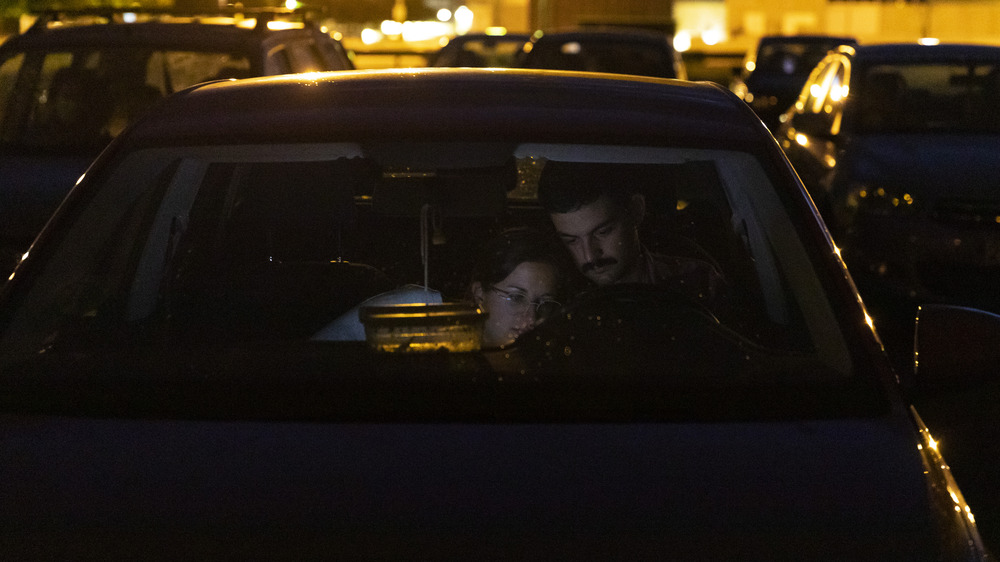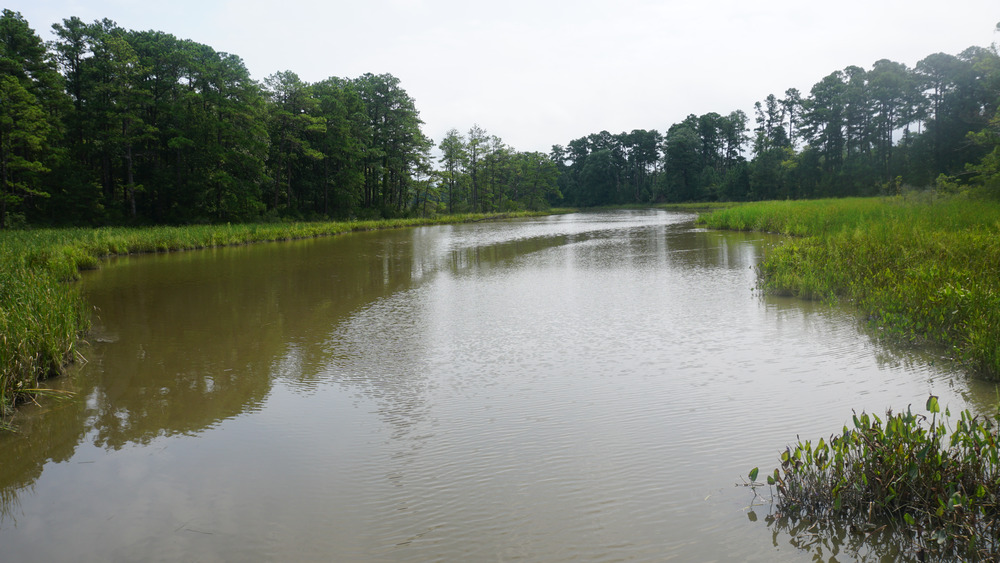The Untold Truth Of The Colonial Parkway Murders
Everybody loves the scenic views of a beautiful road. The 22-mile-long stretch running between Jamestown, Williamsburg, and Yorktown, Virginia, known as Colonial Parkway, is one such road. The thoroughfare is partially maintained by the National Park Service because it's an iconic piece of pavement that connects some of the country's most historic cities. The sightseeing is prime. From pull-offs featuring lush foliage, to memorials, tunnels, and bridges charged with centuries of American history, there's a little something for everyone. But this road flips from a gorgeous sun-lit drive to a haunting trek when the night falls, and it's in part because of the troubled past hidden among this road's lanes.
Throughout the '80s, this thoroughfare was home to what's believed to have been 10 murders. At least eight of these killings comprise the Colonial Parkway murders. The other two happened in the mid-'90s, and their connection to the originals remains a highly debated topic. Regardless, the murders shook the state and instilled an insidious fear during the decade when each killing cropped up within a few years of the others.
Though this case has appeared in the media several times over the past 30+ years, it's still as mysterious as it is unique. Some aspects of the killings fly in the face of the patterns of other serial killers, and some of the facts don't quite add up. Let's check it out.
Two murders for the price of one
Imagine, if you will, sitting in your car, catching your breath after a candle-lit date with your favorite sweetie. Maybe you're reminiscing about sparks that flew during a chemistry-laden conversation, maybe your cheeks are feeling flushed from the back-and-forth banter that lifted you to the clouds, or maybe you're prepping to fog up the windows a little bit. Whatever the details, you're enjoying alone time, thinking this night is as delightful as any date can be, when a third, uninvited individual shows up and turns your romantic date into a horror show.
Where most serial killers murder a single victim at a time, the Colonial Parkway murderer killed two for the price of one. According to Historic Mysteries, this killer targeted couples. Each pair was romantically involved in some way, a couple the killer likely saw as a lustful duo.
Murderers tend to target solo victims. One person is a whole lot easier to kill than two. There's less of a chance that a single victim will get away or fight back. Following the kill, there's the question of cleanup — one body is easier than two. All of that means the Colonial Parkway killer had their work cut out for them, since they're believed to have killed, as Colonial Ghosts points out, between four and five couples.
None of the couples were connected to the other couples
There were only two things the Colonial Parkway murder victims had in common: They were killed near Colonial Parkway, and they were killed in couples. Other than that, it seems the victims didn't have much in common at all. According to NBC, the couples weren't friends with the other couples, nor were they related. It doesn't seem as if they knew each other in the slightest.
The first pair of victims, Cathy Thomas and Rebecca Dowski, were a romantic couple who were last seen alive going out to dinner in 1986, as Oxygen points out. Thomas was a navy veteran turned stockbroker. Dowski worked as a daycare provider and a clerk. The second pair of victims, David Knobling and Robin Edwards, had just met before heading out to a local makeout spot, where they were attacked, according to NBC.
Two Christopher Newport University students on their first date were the next victims on the list in 1988, and the fourth set of victims included Daniel Lauer, who was in the process of moving in with his brother. His brother's girlfriend was the second half of the murdered pair. The only couples that had anything in common seemed to be the first pair and the (potentially connected) final couple, Lollie Winans and Julianne Williams, both of which Historic Mysteries says were lesbian couples, but the others were perceived to be straight couples.
One couple is still missing
Unfortunate couple #3 was Cassandra Lee Hailey and Richard Keith Call. According to NBC, their love was a new, budding thing that would never get the chance to flourish. Both victims were students at Christopher Newport University, not quite of legal age to drink, who were out on their first-ever date. Everything seemed to be going fine as the pair moved their outing to a local party where they enjoyed themselves until around 1:30 a.m. Hailey was an 18-year-old college student. She was young, and she had a curfew. If Call wanted to make a good impression, it was his job to have her home by 2 a.m. They didn't make it.
The probable tragedy struck after the party. The pair is thought to have been murdered, though there's no way we can say that for sure since their bodies, as Colonial Ghosts notes, have never been found. It's been over 30 years, and they're still missing without much of a trace. Call's Toyota Celica was found off Colonial Parkway at the York River Overlook the next morning, but there were no bodies in it and no obvious signs of death.
Some don't believe this pair can be counted in the Colonial Parkway murders because we don't know what happened to the victims, whereas others believe the case bears a convincing resemblance to the others.
The killer was inconsistent
The first set of victims from the Colonial Parkway murders were killed via a mix of strangulation and cut throats. Most serial killers use the same methods each time. But that isn't the case for this killer. According to Oxygen, the Colonial Parkway killer changed things up from victim to victim. The second couple was found nearly a year later in their car, dead of multiple gunshot wounds. One of the two died with her bra around her neck, suggesting she may have been strangled as well. Another couple's remains were too decomposed to find the cause of death, but they were believed to have been stabbed multiple times, as Historic Mysteries details. Then we come to the latest, and presumed to be the final, set of victims: A pair of women who'd been camping together in 1996. They were found dead with their throats cut in a way that was just inches of flesh away from full decapitation. Further, not all experts believe these final victims were connected to others, due to timing and other factors.
Why would this killer switch things up? It's possible they just hadn't found the right fit for acting out on their illness, or that the killer was growing, evolving, branching out their system to better sate dark desires and lessen the possibility of being caught. It's hard to say for certain, but one detective believed they figured out the cause back in 2010.
The killer was never caught, but new evidence has emerged
The murderer in the Colonial Parkway killings was never captured, and Steve Spingola, a private detective, believes he knows why.
According to the Daily Press, Spingola was hired by Annamaria Phelps' family to look into the girl's murder. Along the way, as he notes in his pamphlet Predators on the Parkway: A Former Homicide Detective Explores the Colonial Parkway Murders, he came to the conclusion that the murders weren't the work of a serial killer. Rather, they were the work of multiple killers who coincidentally picked couples in the same area. For instance, Thomas and Dowski's murder was a hate crime, while the murder of Knobling and Edwards was a robbery that took an unfortunate turn. Of course, these are Spingola's musings, and they have yet to be proven.
Spingola's investigation revitalized the cold case, causing a few suspects to surface. A former police officer was arrested after an FBI profiler noticed the victims' windows had been left partially open, suggesting a deadly traffic stop. The former officer in question, Fred Atwell, had also inserted himself into the investigation several times, according to HuffPost. But Atwell died behind bars before his involvement in the killings could be confirmed.
Another man, David Rice, was acquitted after circumstantial evidence, including a pair of restraints and location history, put him on trial for the Winans-Williams murder, according to Historic Mysteries. Not him either. As of now, the killer (or killers) remains at large.





